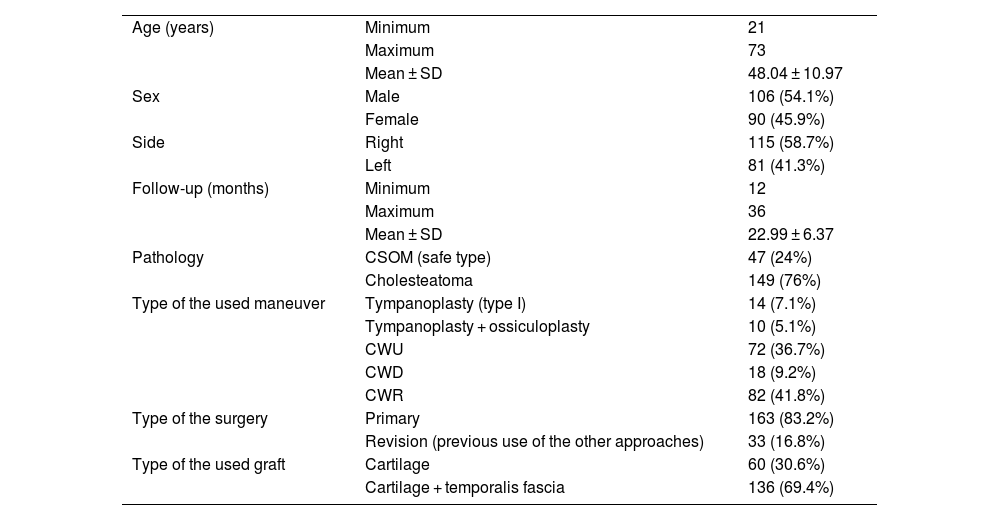This study aimed to describe a new proposed retro-conchal approach for middle ear surgery and to evaluate its advantages and postoperative impact.
MethodologyA retrospective case-series study was held at a tertiary university hospital from March 2008 to April 2022. We included 196 adult patients who were candidates for middle ear surgery because of chronic otitis media. The retro-conchal approach entailed a skin incision on the medial conchal surface 1 cm anterior to the auricular sulcus. It allowed the harvesting of the required size of conchal cartilage and temporalis fascia through the same incision with access into the middle ear and complete exposure to the mastoid process. In addition, we evaluated the use of this approach in tympanoplasty, including cholesteatoma surgeries with at least one-year postoperative follow-up.
ResultThe long-term follow-up (22.9 ± 6.37 months) revealed that most operated cases (89%) did not develop postoperative sequelae related to this approach. On the other hand, 22 patients (11%) developed adverse outcomes, with a statistically significant difference regarding adverse outcomes as the P-value <0.001.
ConclusionAccording to our experience with a relatively large number of patients, the retro-conchal technique was practical for various middle ear surgeries. It allowed optimal access to different middle ear areas and obtaining large-sized conchal cartilage and temporalis fascia (if needed) through the same incision without needing extra surgical steps. In addition, it was a safe maneuver without significant adverse outcomes in the long-term follow-up.
Este estudio tuvo como objetivo describir una nueva propuesta de abordaje retroconchal para la cirugía del oído medio y evaluar sus ventajas e impacto postoperatorio.
MetodologíaSe realizó un estudio retrospectivo de serie de casos en un hospital universitario de tercer nivel desde marzo de 2008 hasta abril de 2022. Se incluyeron 196 pacientes adultos candidatos a cirugía de oído medio por otitis media crónica. El abordaje retroconchal implicó una incisión cutánea en la superficie medial de la concha 1 cm anterior al surco auricular. Permitió la recolección del tamaño requerido de cartílago de la concha y fascia temporal a través de la misma incisión con acceso al oído medio y exposición completa al proceso mastoideo. Evaluamos el uso de este abordaje en la timpanoplastia, incluidas las cirugías de colesteatoma con un seguimiento postoperatorio de al menos un año.
ResultadoEl seguimiento a largo plazo (22,9 ± 6,37 meses) reveló que la mayoría de los casos operados (89%) no desarrollaron secuelas postoperatorias relacionadas con este abordaje. Por otro lado, 22 pacientes (11%) desarrollaron secuelas menores, con diferencia estadísticamente significativa en cuanto a la ocurrencia de secuelas como el valor P < 0,001.
ConclusiónDe acuerdo con nuestra experiencia con un número relativamente grande de pacientes, la técnica retroconchal fue práctica para varias cirugías del oído medio. Permitió un acceso óptimo a diferentes áreas del oído medio y obtener cartílago de la concha y fascia temporal (si es necesario) de gran tamaño a través de la misma incisión sin necesidad de pasos quirúrgicos adicionales. Fue una maniobra segura y sin complicaciones significativas en el seguimiento a largo plazo.









